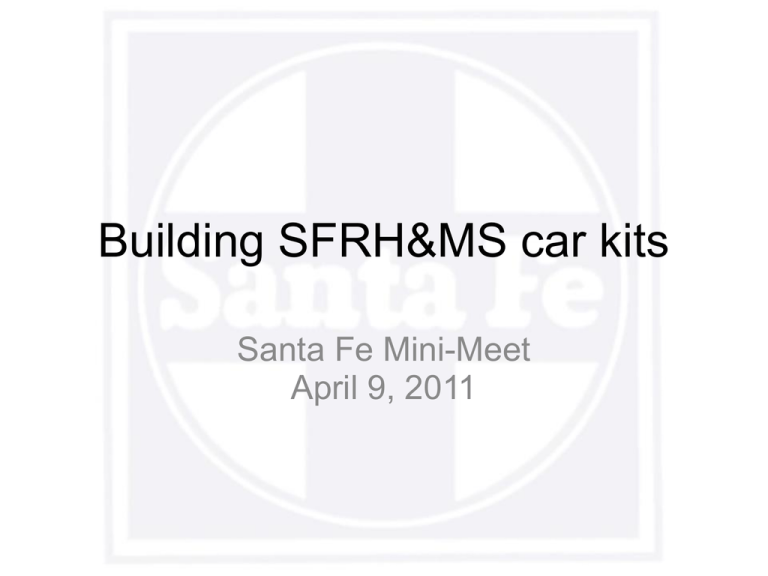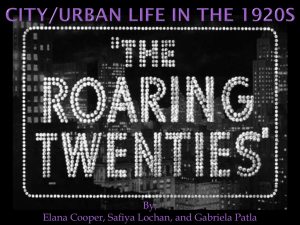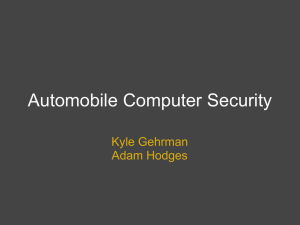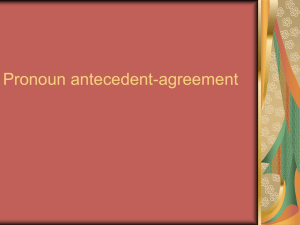Building Society Car Kits - Santa Fe Railway Historical & Modeling
advertisement

Building SFRH&MS car kits Santa Fe Mini-Meet April 9, 2011 Agenda • • • • • • • Introduction Prototype Cars and Kits The Kits and Construction Techniques Lessons Learned Final thoughts Questions Appendix Introduction • Why build kits? o o o o o Interest in passenger and head-end car operations between 1948-1951 Desire for reasonably accurate consists (The Chief, Grand Canyon Express and Fast Mail Express) Can’t afford brass Ready-to-run models not available Enjoy model building Prototype Cars and kits • Heavyweight Cars o o Pullman 1900-1999 series Horse Express car Pullman 1820-1839 series Baggage car • Lightweight Cars o o Pullman 17-1 Sleeper (Chaco – series) Pullman 8-2-2 Sleeper (Tolchico – series) Pullman 1990 class Horse Express • 1990 – 1999 series built in 1930 • Ran on Grand Canyon Express • Distinguishing features are multiple side doors and the end door • Some used till the 60’s Construction Techniques: Horse Car • • • • Photo-etched brass sides, side doors and stirrups Excellent rivet details (double rows) Resin roof, ends, floor and underbody details Directions with reference photos Construction Techniques: General order of assembly • Drill grab iron holes • Wash all parts with brush • Use “Goo” to attach brass to styrene or resin o o • • • • • • “Scuff” brass surfaces with 600 grit paper Theory that “flexible” bond will be more durable Use CA to glue resin to styrene Fit, test fit and glue doors and spacers Fit, test fit and glue sides to ends Fit, test fit and glue roof to sides and ends Fit bottom, add detail parts and then attach floor Attach sill and remaining detail parts Construction Techniques: Horse Car • Use shears to separate parts from brass fret • Drilling holes for grab irons with #80 bit Insert micro-chuck (available from Micro-Mark)in drill press (use same technique for Walthers cars) o Dimples are on the inside of the car – align carefully o Construction Techniques: Horse Car • 0.030” spacer strips between doors and sides for “depth” • Floor mounting tabs are insert so floor bottom is flush with sides • Install corner and end bracing for stiffening (kit comes with resin braces) o Corner braces are set back so sides are flush with ends Construction Techniques: Horse Car • Roof Alignment: Important to align non-door end first, then door end o Roof may have shrunk (up to 0.030”) o Solution: add filler strip on enddoor o Example needed 0.020” filler strip Extend roof filler strips with 0.010” x 0.020 strips and shape to profile Putty, sand and inspect your work and glue rivet strip as last step Construction Techniques: Horse Car • Floor and underbody details: o Note orientation of floor to doors for proper alignment o Bottom of floor is flush with bottom of sides o Cut out floor for door clearance (covered in directions) o Attaching sill is “tricky” due to mating of sides to floor and sill - floor on my model is not easily removable (used CA to glue resin sill to resin floor and tack to brass sides to minimize gaps) o Careful placement of stirrups so trucks can clear 24”curve Construction Techniques: Finishing • Inspect work • Wash and air dry • Primer and painting: Used Polly S and ModelFlex paints using a single-action airbrush (Prefer Polly S) o Heavyweights: Entire models shot with “Santa Fe” green then brush-painted black roofs o • Decals o Used mainly Microscale and some Champ • Weathering: o o Dusted with Polly S “dust” and “earth” colors Finished with powdered pastels Construction Techniques: Horse Car • Finished product – lightly weathered Pullman 1800-1839 Baggage car • 1800 – 1819 Mail storage cars built in 1917 • 1820 – 1839 Baggage and Express cars built between 1927 and 1929 • Majority of cars converted to MOW use Construction Techniques: Baggage Car • Brass sides, doors, stirrups • Resin roof, ends floor and underbody • Directions with fewer photos (older kit) • Same order of assembly • Make sure to align floor with sides (Floor casting “N” aligns with narrow door) Construction Techniques: Baggage Car • Underbody details Channels supplied with cutouts for braces o Detail parts supplied in resin or plastic o Placement indicated in directions o Brake plumbing is an educated guess o • Doors o o Add 0.030” filler strip for depth Spacer included for safety bars Construction Techniques: Baggage Car • Floor and roof short due to shrinkage o Solution used: sand end pieces to fit (thinner ends vs. filing sides) o Better: cut roof at a rivet seam and insert shim (like the horse car) • End bracing o End and roof gaps filled and sanded o Add bracing to minimize cracking • Pads for screws to attach floor (set back bottom of floor so it is flush with sides (drill and tap with 2-56 screws) o Note placement of pads to avoid interference with detail parts Construction Techniques: Baggage Car • Truck mounted generator: o Directions not clear so look at prototype photos o Solution: Baggage Car – Finished model Pullman 17-1 Sleeper • Chaco-series: 8 cars delivered in 1938 for The Chief • All converted to coaches in 1960 • Pictured below is the Chimayo after the coach conversion • PS roofs made from “Cor-Ten” steel, not stainless steel and were apparently painted (Budd roofs were stainless steel Construction Techniques: Pullman 17-1 • • • • AMB core kit (roof, ends and floor) Nickel-plated etched brass sides Same order of construction Shim strip on the top of the sides corrects spacing (etched sides thinner than plastic sides) • Add floor spacer strip (critical alignment) • Add bolster fillers to prevent gaps Construction Techniques: Pullman 17-1 • Build simplified interior using 0.020” styrene based upon Pullman blueprints, add seats and benches • Add kit supplied underbody components • Add details and glaze windows with 0.005” clear styrene Construction Techniques: Pullman 17-1 • Bend skirts around 1” dowel • Floor is held in by skirts and is removable • Trim Microscale decals to fit • Name plate too narrow for decals, add 0.01” aluminum overlay Pullman 8-2-2 Sleeper • Tolchico-series: 14 cars delivered in 1938 for The Chief • Most rebuilt to coaches in 1962 • Pictured below is the Toroweap Construction Techniques: Pullman 8-2-2 • AMB core kit (roofs, ends and floor) • Nickel-plated brass sides • Same order of construction as others: glue sides and ends then roof • Other construction details are virtually the same as the 17-1 o No issues with adding decal to name plate Construction Techniques: Finish on nickel-plated cars • Personal preference: nickel-plating is too shiny • Toned down with matte finish • Differences in Pullman fluting between cars due to different suppliers (NKP on the left – 17-1) Lessons learned • Overall: o o o o o Take your time and have fun Read, re-read and read again all instructions Adopt an “order of construction” and follow it Dry fit all parts prior to gluing (or tack with CA) Measure, measure and measure • Heavyweight o o o o Use filler strips to lengthen a short roof as necessary Resin is brittle, prone to shrinkage and warping Filing brass stirrups without bending them is a challenge Didn’t add window bars on Horse Car • Lightweight o o Underbody detail – align with etched hatches Painting roof and ends – use Alclad to get a better match? Modeler’s license: some cars had roofs re-painted silver after WWII (roofs painted black during the war) and PS roofs were apparently not stainless steel. Final Thoughts • Kits are not perfect but enjoyable to work on and personally very happy with results: o o o o Will buy 2-3 baggage cars (when re-stocked) New car is a available (1976 – 1979 baggage and express) Will buy “fish belly” baggage car (when available) Will buy 60-series RPO car (when available) Need only one Horse car (restocked!!) Questions Thank You!! Presentation posted on Goggle Documents: https://docs.google.com/present/edit?id=0ASSlmh6s65dXZGR0cXNtdzhfMTEzYzNmOHc2ZHY&hl= en&authkey=COTU4qAC Feel free to email me with questions or comments: c.kikawa@comcast.net Special Thanks Tom Casey: Slide decks and insight into the kits Baggage Car: https://docs.google.com/leaf?id=0BySlmh6s65dXMDY5ODJkOTEtNTk3Yi00MTBhLWEwNjgtNzk5M TQzYzE0MmNk&sort=name&layout=list&num=50 Prototypes: https://docs.google.com/leaf?id=0BySlmh6s65dXNzY4YTU0MjgtOGMwMS00OGY4LWE2YTAtNmZ mNGM2OTdhZWRj&sort=name&layout=list&num=50 Diner: https://docs.google.com/leaf?id=0BySlmh6s65dXODI3ZjdlNjAtOTU5Zi00M2I4LWIyM2EtMGEyMWU 0NjY2MDM5&sort=name&layout=list&num=50 Appendix: • • • • Kits Resources Details Tools The Kits • Order from the Society page: http://www.atsfrr.net/store/index.htm • Heavyweight Cars: o o o o o Photo-etched brass sides and stirrups Resin Roofs, Floors and underbody Trucks, no wheels Manufactured by NKP Sides (Tom Schneid) Masters by Tom Casey • Lightweight Cars o o o Nickel plated brass sides AMB cores supplied (roof, underbody and some details) Trucks, no wheels Resources • Websites o o o http://www.atsfrr.net/ http://www.qstation.org http://passcarphotos.info • Books o o o o o Head End Cars Painting and Lettering Guide A Quarter Century of Santa Fe Consists The Official Pullman Standard Library – Santa Fe ATSF Color Guide to Freight and Passenger Equipment • Articles: Passenger cars from core kits (Model Railroader, March and April 2005) o Santa Fe Chief (Mainline Modeler, June 1992) o Details Parts • Grab irons: Detail Associates o o o • • • • • • • • • • • • Glazing: Evergreen clear styrene 0.005” Weights: A-Line Wheel sets: Kadee 36” Signal and steam lines: Cal Scale (190-275) Air hoses: Hi Tech Details (made of flexible rubber) Couplers: Kadee #58 Diaphragms: American Limited (9100) Coupler lift bars: Detail Associates Chain: Detail Associates Safety Chain Brass Wire (0.012” for most handrails) Detail Associates Brake Wheels: Detail Associates Paint: ModelFlex and Polly S paints (CN Green) o o • End 17” Drop (2202) End 22” x 22” Corner Grabs (6205) Roof 28” Ladder Type F/E Units (2215) Personally prefer Polly S as they are “easier” to apply Interior paints use craft paints available from Michaels Decals: Microscale and Champ Horse Express (87-1043): SF Head-end and Express Cars Baggage (87-1105): SF Heavyweight Passenger Cars Champ decals are correctly sized for the baggage car but harder to work with (thicker and brittle due to age) o Pullman (87-061): Streamline /GS Sleepers (1939-1971) o o Tools • • • • • • • • • Xuron cutters Needle nose, bending loop and other pliers Needle files Pin vise and various sized bits X-acto blades: round corners of #17 blade to prevent “digging in” Micro Sanding Wands (Micro-Mark # 81471) Wet-dry sand paper (600, 800 and 1200 grits) Goo and CA (medium set) Good light and magnifiers






